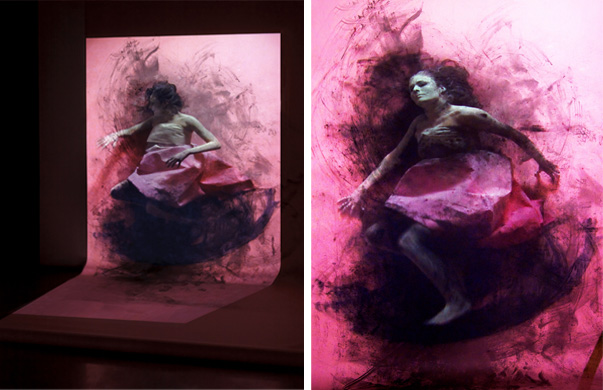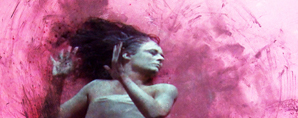XIA 2011 Philomène Longpré
June 10 – July 9, 2011
SAW Video & 101 Gallery – Ottawa
Sept 6 – Oct 7, 2011
Main Gallery FOFA Galley – Montreal
March 24 – May 13, 2012
MSVU Art Gallery – Halifax
May 22-25, 2012
Conferences C2MTL – Montreal</FONT SIZE>
A responsive system in which visitor’s presence triggers different emotional stages of a projected virtual character. XIA’s exhibit by Longpré questions the screen’s materiality, spatiality, and interactivity as influential factors in augmented bodily experiences of selected moving images. Since 1999, Philomène Longpré, an artist and multisensory media researcher, has been developing a series of screen-reliant art systems that translate body language and behavioral patterns while exploring intricate interactions between the physical and virtual worlds. XIA was funded by SSHRC, CALQ, and Concordia University.

Extract from XIA Exhibition Text:
The Various Contrivances of Philomène Longpré by Alison Syme
Xia. In a darkened gallery space, on a luscious, luminous carnation ground, a velvety black charcoal bloom – like the dusky, polleny heart of a poppy – is both the setting and the trace of a captive’s struggle. The caught creature’s body is sheathed in pale pink; periodically a dark vermilion wing unfurls from the body or curls around it. In a state of rest, she appears to float weightlessly in her dusty den, but she springs into activity as the viewer approaches. Legs scrabble; head and arms jerk mechanically; hands reach out to either side as if to ward off something or someone sensed but unseen. But even as she writhes, slowly turns, or curls up into a foetal position, the near-weightless being remains trapped in her flowery prison. To the sounds of crickets, water, creaking wood industry, and traffic, the life-sized figure’s identity oscillates between swirling dancer, suspended siren, and franticly fluttering bird or butterfly. Incalculable time passes as we watch. As she moves, the creature becomes more and more coated in black dust; her facial features disappear under a velvet mask. At moments she vanishes, flickers out of sight; at others she freezes in strobe light. As though a microcosm enormously magnified, the figure in her radiant carnation snare seems like a close-up from a nature film. The tableau is beautiful and harrowing; w are captivated by this scene of capture. What is the nature of perception, of our susceptibility to sensorial wiles? Elaine Scarry has examined the imaginative consequences of the “antecedents of human perception in the membranes of plants;” she describes the way petals function imaginarily as figures of the “mental retina” on which images are formed for us. 1 (…) In Xia the paper screen and lush charcoal are both vegetable substances. The carnation ground unfurls onto the gallery floor, tempting the viewer to step into the floral trap. The viewer’s condition is like that of the projected figure who, flitting and wallowing in her powdery lair, is ethereal fairy and mud-painted native, Ariel and Caliban at once. Drawn to both the dream of flight and the gorgeous colour, we are caught in nets of light and stained with our own desire.
1 Elaine Scarry, Dreaming by the Book (New York: Farrar, Strauss, and Giroux, 1999), 68, 49.
Alison Syme is Associate Professor of Modern Art at the University of Toronto. She received her Ph.D. from Harvard University in 2005. Syme is also the author of A Touch of Blossom: John Singer Sargent and the Queer Flora of Fin-de-Siècle Art (Penn State University Press, 2010).</FONT SIZE>
XIA – selected publications:
Isa Tousignant’s Top 3: Into the Deeps.
Isa Tousignant. Canadian Art Magazine. Dec. 2011
Between Darkness and Light.
Rebecca Hiscott. The Link. Sept.13, 2011
Moving among moving images: Philomene Longpre’s Xia.
Jaenine Parkinson. Artengine. August, 2011
Layoffs & Caravaggio at the National Gallery/Body Tracks at Gallery 101.
Andrew Wright. Akimbo. June 2011


